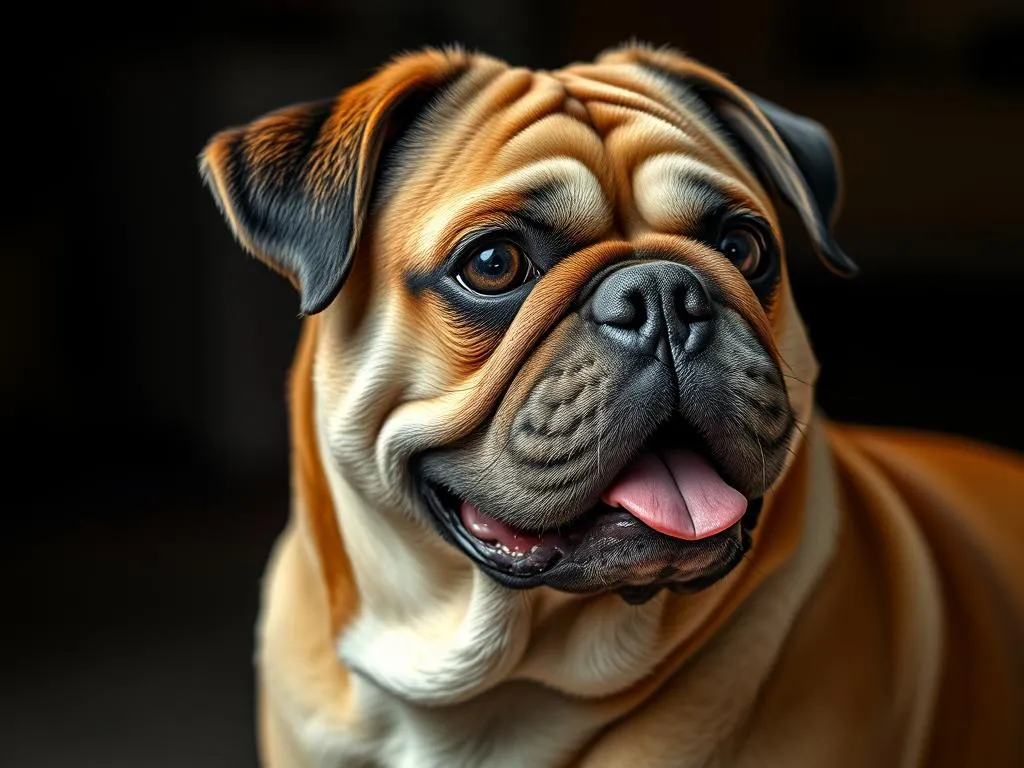
When we think of dogs, we often picture fluffy, tail-wagging companions, and some breeds, affectionately termed as “pudgy,” bring a unique charm to our lives. But what exactly does “pudgy” mean in the context of dog breeds? Generally, it refers to dogs that have a rounder, stockier body shape, often accompanied by a playful disposition. Understanding the various characteristics of these breeds not only aids in choosing the right companion but also prepares potential owners for the responsibilities that come with them.
Characteristics of Pudgy Dogs
Physical Traits
Pudgy dogs typically possess a variety of physical traits that set them apart. They often have stocky builds, with broad chests and sturdy limbs. Their coats can vary widely, from short and smooth to long and fluffy, depending on the breed. Typical examples of pudgy body structures can be found in breeds like Bulldogs, Pugs, and Basset Hounds.
In terms of weight, many pudgy breeds range from about 20 to 70 pounds, but this can vary significantly. For instance, the English Bulldog usually weighs between 40 to 50 pounds, while a Pug might only tip the scales at 14 to 18 pounds. Despite their size differences, these breeds share a certain robust appearance that endears them to dog lovers.
Temperament
When it comes to temperament, pudgy dogs are often known for their friendly and affectionate nature. Many of these breeds are social and enjoy being around people and other pets, making them great family companions. For example, Pugs are known for their playful antics and charming personalities, while Basset Hounds are more laid-back, often displaying a calm demeanor.
Pudgy dogs can also be quite loyal and protective, traits that make them excellent watchdogs. However, potential owners should be aware that some of these breeds may exhibit stubbornness during training, requiring patience and consistent reinforcement.
Health Considerations
Despite their charm, pudgy dogs can face specific health considerations that owners need to be aware of. Many of these breeds are prone to obesity, which can lead to various health issues such as joint problems, diabetes, and respiratory difficulties. Maintaining a healthy weight is crucial for the longevity and quality of life of pudgy dogs.
Regular veterinary check-ups can help monitor these health risks. Additionally, it’s essential for owners to focus on balanced diets and exercise to keep their furry friends fit and healthy.
Popular Pudgy Dog Breeds
Bulldog Breeds
English Bulldog
The English Bulldog is perhaps one of the most iconic pudgy breeds. With their distinctive wrinkled faces and muscular bodies, they usually weigh between 40 to 50 pounds. Their short, smooth coat comes in various colors, often with a mix of white, brindle, and fawn.
In terms of personality, English Bulldogs are gentle and affectionate. They thrive on companionship and can be quite lazy, enjoying long naps throughout the day. However, they do require regular exercise to maintain a healthy weight, despite their love for lounging.
French Bulldog
The French Bulldog shares some similarities with the English Bulldog but is smaller and has a more playful disposition. Typically weighing between 16 to 28 pounds, they have distinctive bat-like ears and a compact body structure. French Bulldogs are highly social and can adapt well to apartment living, making them popular in urban settings.
They are known for their quirky behavior and love for companionship, often forming strong bonds with their owners. However, like their English counterparts, they can also face health issues, particularly related to their breathing due to their flat faces.
Pugs
Pugs are another breed that falls under the “pudgy” category. These small dogs, usually weighing between 14 to 18 pounds, are characterized by their round faces, curly tails, and short legs. Pugs are known for their playful and affectionate nature, making them great companions for families and individuals alike.
However, Pugs are also prone to several health concerns, including obesity and respiratory problems due to their brachycephalic structure. Owners should monitor their weight closely and ensure they get regular exercise to keep them healthy.
Basset Hound
The Basset Hound is a classic pudgy breed, known for their long ears and droopy expression. Weighing between 40 to 65 pounds, Basset Hounds have a unique body structure with short legs and a long body. They are friendly and easygoing, often getting along well with children and other pets.
One significant health concern for Basset Hounds is their susceptibility to ear infections due to their long ears. Additionally, they can face joint issues, particularly if they become overweight. Regular vet check-ups and a healthy diet are essential for this breed.
Corgi
Corgis, particularly the Pembroke Welsh Corgi and the Cardigan Welsh Corgi, are small yet pudgy dogs known for their short legs and long bodies. Weighing between 24 to 30 pounds, Corgis are intelligent and energetic, requiring regular exercise to maintain a healthy weight.
Their friendly demeanor makes them great family pets, and they are often good with children. However, potential owners should be prepared for their herding instincts, which may lead to chasing after smaller animals.
Other Notable Breeds
Several other breeds also fit into the pudgy category, including:
-
Shih Tzu: Known for their long, flowing coats and affectionate nature. They typically weigh between 9 to 16 pounds.
-
Dachshund: With their long bodies and short legs, Dachshunds weigh between 16 to 32 pounds. They are known for their playful and curious personalities.
These breeds share many characteristics, including a tendency to be affectionate, loyal, and sometimes stubborn.
Choosing the Right Pudgy Dog for You
Lifestyle Considerations
Before bringing a pudgy dog into your home, it’s essential to assess your lifestyle. Consider your living situation—do you have enough space for a larger breed, or would a smaller dog suit you better? Additionally, your activity level can influence which breed is the best fit; some pudgy breeds require more exercise than others.
Family Compatibility
Another critical factor is family compatibility. If you have children or other pets, it’s essential to consider how different breeds interact with them. For instance, Bulldogs and Pugs tend to be great with kids, while some breeds may require more supervision around younger children.
If you’re a first-time dog owner, opting for a breed that’s known for being more adaptable and easier to train can lead to a more enjoyable experience.
Adoption vs. Buying
When it comes to acquiring a pudgy dog, you have the option of adopting from a shelter or purchasing from a breeder. Adoption often comes with the benefit of saving a life and can be a rewarding experience. Many shelters have a wide variety of pudgy breeds looking for loving homes.
On the other hand, purchasing from a reputable breeder allows you to know the dog’s lineage and potential health issues. Research is crucial in either case to ensure you’re making the best choice for both you and the dog.
Care and Maintenance of Pudgy Dogs
Diet and Nutrition
Feeding pudgy dogs the right diet and nutrition is critical. Many of these breeds are prone to obesity, so portion control and a balanced diet are essential. Look for high-quality dog food that meets their nutritional needs, and consult your veterinarian for specific recommendations.
Establishing a consistent feeding schedule can also help manage their weight. Treats should be given sparingly and should be healthy options.
Exercise Needs
Regular exercise is vital for pudgy breeds to maintain a healthy weight. Depending on the breed, daily walks, playtime, or even swimming can be great activities. For instance, Bulldogs may enjoy shorter walks due to their breathing issues, while Corgis require more vigorous activity to keep them engaged.
Always monitor your dog during exercise to prevent overheating, especially in brachycephalic breeds.
Regular Health Check-Ups
Routine health check-ups are essential for pudgy breeds to catch any potential health issues early. Regular vet visits can help monitor weight, dental health, and overall wellness. Make sure to discuss any breed-specific health screenings your dog might need.
Grooming Requirements
Grooming needs vary based on the breed. Short-haired breeds like Bulldogs may require less maintenance, while long-haired breeds like Shih Tzus need regular brushing to prevent matting. Nail trimming and regular baths are essential for all breeds to keep them clean and healthy.
Training and Socialization
Basic Training Techniques
Training pudgy dogs can be a rewarding experience. Using positive reinforcement techniques is often the most effective way to instill good behaviors. Treats, praise, and playtime can motivate your dog to learn commands and appropriate behaviors.
Be consistent with training sessions, and start early to establish good habits. Stubbornness can be common in some pudgy breeds, so patience is key.
Socialization Tips
Proper socialization is crucial for pudgy dogs to ensure they are well-adjusted and comfortable in various environments. Introduce your dog to different people, pets, and situations gradually. Puppy classes can be an excellent way to facilitate socialization and training simultaneously.
Regular exposure to new experiences will help your dog develop confidence and reduce anxiety in unfamiliar situations.
Fun Facts about Pudgy Dogs
Historical Background
Many popular pudgy breeds have fascinating historical backgrounds. For instance, the English Bulldog was originally bred for bull-baiting, but today they are cherished companions. Pugs have a rich history as companions to Chinese emperors, showcasing their long-standing appeal.
Celebrity Pudgy Dogs
Pudgy dogs have also made their mark in pop culture. Characters such as Brian Griffin from Family Guy and the lovable dogs from various animated films have contributed to the popularity of breeds like Pugs and Bulldogs.
Interesting Trivia
Did you know that Pugs have a unique ability to snore? Their flat faces can lead to distinctive sounds during sleep. Additionally, Bulldogs have a distinctive gait, often described as a “waddle,” due to their heavy build.
Conclusion
Understanding what breed of dog is pudgy can lead to a fulfilling and joyful companionship. These breeds possess unique characteristics that make them endearing, but they also come with specific responsibilities. Whether you’re considering adopting a Pug, Bulldog, or Basset Hound, it’s essential to be informed and prepared for the unique needs of these adorable companions.
By focusing on their health, training, and socialization, you can ensure that your pudgy dog leads a happy and healthy life. Embrace the joy and companionship that comes with having a pudgy dog, and take pride in being a responsible pet owner.









